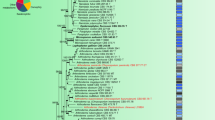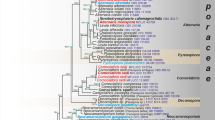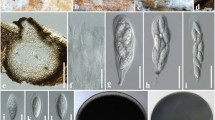Abstract
Ochroconis is a genus of ascomycete fungi that includes oligotrophic saprobes and some opportunistic species causing infections in vertebrates. The most important of these opportunists is the neurotropic species Ochroconis gallopava, which occurs in birds and occasionally in immunocompromised humans. Other Ochroconis species have been isolated from superficial infections of cats, dogs and fish. In their natural environment, these species are found in litter, soil, and on moist surfaces. Some thermophilic species have been isolated from hot springs, industrial effluents, and self-heated plant material. Although their ecology and epidemiology has been investigated, their classification within the ascomycetes is still unknown. Here, the phylogenetic placement of Ochroconis is investigated using a four-gene phylogeny (nuLSU, nuSSU, mtSSU and RPB2). The results show that Ochroconis and its recently described sister genus Verruconis belong to the order Venturiales (Dothideomycetes) and are nested within the Sympoventuriaceae, a family recently erected for a group of plant-saprobes or -pathogens sister to the Venturiaceae. They form a well-supported monophyletic group together with five species of the anamorphic genus Fusicladium isolated from leaf and needle litters.


Similar content being viewed by others
References
Abbott EV (1927) Scolecobasidium, a new genus of soil fungi. Mycologia 19:29–31
Barenfanger J, Ramirez F, Tewari RP et al (1989) Pulmonary phaeohyphomycosis in a patient with hemoptysis. Chest 95:1158–1160
Barron GI, Busch LV (1962) Studies on the soil hyphomycete Scolecobasidium. Can J Bot 40:77–84
Beck A, Ritschel A, Schubert K, Braun U, Triebel D (2005) Phylogenetic relationships of the anamorphic genus Fusicladium s. lat. as inferred by ITS nrDNA data. Mycol Prog 4:111–116
Bhatt GC, Kendrick WB (1968) The generic concepts of Diplorhinotrichum and Dactylaria, and a new species of Dactylaria from soil. Can J Bot 46:1253–1257
Boggild AK, Poutanen SM, Mohan S, Ostrowski MA (2006) Disseminated phaeohyphomycosis due to Ochroconis gallopavum in the setting of advanced HIV infection. Med Mycol 44:777–782
Braun U, Crous PW, Dugan F, Groenewald JZ, de Hoog GS (2003) Phylogeny and taxonomy of Cladosporium-like hyphomycetes, including Davidiella gen. nov., the teleomorph of Cladosporium s. str. Mycol Progr 2:3–18
Brokalaki EI, Sommerwerck U, von Heinegg EH, Hillen U (2012) Ochroconis Gallopavum infection in a lung transplant recipient: report of a case. Transplant Proc 44:2778–2780
Bussaban B, Lumyong S, Lumyong P, Seelanan T, Park DC, McKenzie EHC, Hyde KD (2005) Molecular and morphological characterization of Pyricularia and allied genera. Mycologia 97:1002–1011
Crous PW, Schubert K, Braun U, de Hoog GS, Hocking AD, Shin H-D, Groenewald JZ (2007a) Opportunistic, human-pathogenic species in the Herpotrichiellaceae are phenotypically similar to saprobic or phytopathogenic species in the Venturiaceae. Stud Mycol 58:185–217
Crous PW, Mohammed C, Glen M, Verkley GJM, Groenewald JZ (2007b) Eucalyptus microfungi from culture. 3. Eucasphaeria and Sympoventuria genera nova, and new species of Furcaspora, Harknessia, Heteroconium and Phacidiella. Fungal Divers 25:19–36
Dwivedi RS (1959) Occurrence of the genus Scolecobasidium Abbott in India. Curr Sci Bangalore 28:374–375
Ellis MB (1971) Dematiaceous Hyphomycetes. Commonwealth Mycological Institute, Kew
Fader RC, McGinnis MR (1988) Infections caused by dematiaceous fungi: chromoblastomycosis and phaeohyphomycosis. Infect Dis Clin North Am 2:925–938
Fukushiro R, Udagawa S, Kawashima Y, Kawamura Y (1986) Subcutaneous abscesses caused by Ochroconis gallopavum. J Med Vet Mycol 24:175–182
Gargas A, Taylor JW (1992) Polymerase chain reaction (PCR) primers for amplifying and sequencing 18S rDNA from lichenized fungi. Mycologia 84:589–592
Ge YP, Lv GX, Shen YN, Li M, Deng SW, de Hoog GS, Samerpitak K, Liu WD (2012) First report of subcutaneous phaeohyphomycosis caused by Ochroconis tshawytschae in an immunocompetent patient. Med Mycol 50:637–640
Georg LK, Bierer BW, Cooke WB (1964) Encephalitis in turkey poults due to a new fungus species. Sabouraudia 3:239–244
Hollingsworth JW, Shofer S, Zaas A (2007) Successful treatment of Ochroconis gallopavum infection in an immunocompetent host. Infection 35:367–369
de Hoog GS (1985) Taxonomy of the Dactylaria complex, IV. Dactylaria, Neta, Subulispora and Scolecobasidium. Stud Mycol 26:1–60
de Hoog GS, von Arx JA (1973) Revision of Scolecobasidium and Pleurophragmium. Kavaka 1:55–60
de Hoog GS, Guarro J, Gené J, Figueras MJ (2000) Atlas of clinical fungi, 2nd edn. Centraalbureau voor Schimmelcultures, Universitat Rovira i Virgili, Utrecht
Horré R, de Hoog GS, Klucsny C, Marklein G, Schaal KP (1999) rDNA diversity and physiology of Ochroconis and Scolecobasidium species reported from humans and other vertebrates. Stud Mycol 43:194–205
James TY, Kauff F, Schoch C et al (2006) Reconstructing the early evolution of the fungi using a six-gene phylogeny. Nature 443:818–822
Kirk PM, Cannon PF, Minter DW, Stalpers JA (2008) Ainsworth & Bisby’s dictionary of the fungi, 10th edn. CAB International, Wallingford
Koukol O (2010) Revision of “Septonema ochraceum” revealed three new species of Venturiaceae and Herpotrichiellaceae. Mycol Progr 9:369–378
Kralovic SM, Rhodes JC (1995) Phaeohyphomycosis caused by Dactylaria (human dactylariosis): report of a case with review of the literature. J Infect 31:107–113
Liu YJ, Whelen S, Hall BD (1999) Phylogenetic relationships among ascomycetes: evidence from an RNA polymerase II subunit. Mol Biol Evol 16:1799–1808
Lutzoni F, Wagner P, Reeb V, Zoller S (2000) Integrating ambiguously aligned regions of DNA sequences in phylogenetic analyses without violating positional homology. Syst Biol 49:628–651
Maddison WP, Maddison DR (2003) MacClade: Analysis of phylogeny and character evolution. Version 4.6. Sinauer, Sunderland
Martin-Sanchez PM, Nováková A, Bastian F, Alabouvette C, Saiz-Jimenez C (2012a) Two new species of the genus Ochroconis, O. lascauxensis and O. anomala isolated from black stains in Lascaux Cave, France. Fungal Biol 116:574–589
Martin-Sanchez PM, Bastian F, Alabouvette C, Saiz-Jimenez C (2012b) Real-time PCR detection of Ochroconis lascauxensis involved in the formation of black stains in the Lascaux Cave, France. Sci Total Environ 443:478–484
Mason-Gamer R, Kellogg E (1996) Testing for phylogenetic conflict among molecular datasets in the tribe Triticeae (Graminae). Syst Biol 45:524–545
Mazur JE, Judson MS (2001) A case report of a Dactylaria fungal infection in a lung transplant patient. Chest 119:651–653
McGinnis MR (1983) Chromoblastomycosis and phaeohyphomycosis: new concepts, diagnosis, and mycology. J Am Acad Dermatol 8:1–16
Meriden Z, Marr KA, Lederman HM, Illei PB, Villa K, Riedel S, Carroll KC, Zhang SX (2012) Ochroconis gallopava infection in a patient with chronic granulomatous disease: case report and review of the literature. Med Mycol 50:883–889
Möller EM, Bahnweg G, Sandermann H, Geiger HH (1992) A simple and efficient protocol for isolation of high molecular weight DNA from filamentous fungi, fruit bodies, and infected plant tissues. Nucleic Acids Res 20:6115–6116
Morgan-Jones G, Jacobsen BJ (1988) Notes on hyphomycetes. LVIII. Some dematiaceous taxa, including two undescribed species of Cladosporium, associated with biodeterioration of carpet, plaster and wallpaper. Mycotaxon 32:223–236
Nováková A (2009) Microscopic fungi isolated from the Domica Cave system (Slovak Karst National Park, Slovakia). A review. Int J Speleol 38:71–82
Oddell JA, Alvarez S, Cvitkovitch DG, Cortese DA, McComb BL (2000) Multiple lung abscesses due to Ochroconis gallopavum, a dematiaceous fungus, in a nonimmunocompromised wood pulp worker. Chest 118:1503–1505
Ohori A, Endo S, Sano A, Yokoyama K, Yarita K, Yamaguchi M, Kamei K, Miyaii M, Nishimura K (2006) Rapid identification of Ochroconis gallopava by loop-mediated isothermal amplification (LAMP) method. Vet Microbiol 114:359–365
Okeke CN, Gugnani HC (1987) In vitro sensitivity of environmental isolates of pathogenic dematiaceous fungi to azole compounds and a phenylpropyl-morpholine derivative. Mycopathologia 99:175–181
Padhye AA, Amster RL, Browning M, Ewing EP (1994) Fatal encephalitis caused by Ochroconis gallopava in a domestic cat. J Med Vet Mycol 32:141–145
Paulus B, Gadek P, Hyde KD (2003) Two new species of Dactylaria (anamorphic fungi) from Australian rainforests and an update of species in Dactylaria sensu lato. Fungal Divers 14:143–156
Prenafeta-Boldú FX, Summerbell R, de Hoog GS (2006) Fungi growing on aromatic hydrocarbons: biotechnology’s unexpected encounter with biohazard? FEMS Microbiol Reviews 30:109–130
Rehner SA, Samuels GJ (1994) Taxonomy and phylogeny of Gliocladium analysed from nuclear large subunit ribosomal DNA sequences. Mycol Res 98:625–634
Revankar SG, Sutton DA (2010) Melanized fungi in human disease. Clin Microbiol Rev 23:884–928
Rippon JW, Gerhold R, Heath M (1980) Thermotolerant fungi isolated from the thermal effluent of nuclear power generating reactors; dispersal of human opportunistic and veterinary pathogenic fungi. Mycopathologia 70:169–179
Ronquist F, Huelsenbeck JP (2003) MRBAYES 3: Bayesian phylogenetic inference under mixed models. Bioinformatics 19:1572–1574
Salkin IF, Dixon DM, Kemna ME, Danneman PJ, Griffith JW (1990) Fatal encephalitis caused by Dactylaria constricta var. gallopava in a snowy owl chick (Nectea scandiaca). J Clin Microbiol 28:2845–2847
Samerpitak K, Van der Linde E, Choi H-J, Gerrits van den Ende AHG, Machouart M, Gueidan C, Hoog GS de (2013) Taxonomy of Ochroconis, genus including opportunistic pathogens on humans and animals. Fungal Diversity. doi:10.1007/s13225-013-0253-6
Schoch CL, Sung G-H, López-Giráldez F et al (2009) The Ascomycota tree of life: a phylum-wide phylogeny clarifies the origin and evolution of fundamental reproductive and ecological traits. Syst Biol 58:224–239
Schubert K, Ritschel A, Braun U (2003) A monograph of Fusicladium s.lat. (Hyphomycetes). Schlechtendalia 9:1–132
Seyedmousavi S, Guillot J, de Hoog GS (2013) Phaeohyphomycoses, emerging opportunistic diseases in animals. Clin Microbiol Rev 26:19–35
Sides EH, Benson JD, Padhye AA (1991) Phaeohyphomycotic brain abscess due to Ochroconis gallopavum in a patient with malignant lymphoma of large cell type. J Med Vet Mycol 29:317–322
Singh K, Flood J, Welsh RD, Wyckoff JH, Snider TA, Sutton DA (2006) Fatal systemic phaeohyphomycosis caused by Ochroconis gallopavum in a dog (Canis familaris). Vet Pathol 43:988–992
Stamatakis A, Hoover P, Rougemont J (2008) A rapid bootstrap algorithm for the RAxML web-servers. Syst Biol 75:758–771
Stamatakis A, Ludwig T, Meier H (2005) A fast program for maximum likelihood-based inference of large phylogenetic trees. Bioinformatics 21:456–463
Swofford DL (1999) PAUP*: phylogenetic analysis using parsimony (* and other methods) Version 4.0b10. Sinauer, Sunderland
Tansey MR, Brock TD (1973) Dactylaria gallopava, a cause of avian encephalitis, in hot spring effluents, thermal soils and self heated coal waste piles. Nature 242:202–203
Tansey MR, Fliermans CB, Kern CD (1979) Aerosol dissemination of veterinary pathogenic and human opportunistic thermophilic and thermotolerant fungi from thermal effluents of nuclear production reactors. Mycopathologia 69:91–115
Vilgalys R, Hester M (1990) Rapid genetic identification and mapping of enzymatically amplified ribosomal DNA from several Cryptococcus species. J Bacteriol 172:4238–4246
Waldrip DW, Padhye AA, Ajello L, Ajello M (1974) Isolation of Dactylaria gallopava from broiler-house litter. Avian Dis 18:445–451
White TJ, Bruns TD, Lee S, Taylor JW (1990) Amplification and direct sequencing of fungal ribosomal RNA genes for phylogenetics. In: Innis MA, Gelfand DH, Sninsky JJ, White TJ (eds) PCR protocols: a guide to methods and applications. Academic, San Diego, pp 315–322
Xin L, de Hoog GS (2010) Indoor wet cells harbour melanized agents of cutaneous infection. Med Mycol 48:622–628
Yarita K, Sano A, Murata Y, Takayama A, Takahashi Y, Takahashi H, Yaguchi T, Ohori A, Kamei K, Miyaji M, Nishimura K (2007) Pathogenicity of Ochroconis gallopava isolated from hot spring in Japan and a review of published reports. Mycopathologia 164:135–147
Zhang Y, Crous PW, Schoch CL, Bahkali AH, Guo LD, Hyde KD (2011) A molecular, morphological and ecological re-appraisal of Venturiales – a new order of Dothideomycetes. Fungal Divers 51:249–277
Zoller S, Scheidegger C, Sperisen C (1999) PCR primers for the amplification of mitochondrial small subunit ribosomal DNA of lichen-forming ascomycetes. Lichenologist 31:511–516
Acknowledgements
The authors would like to thank Conrad Schoch for providing alignments for this study and the collection staff from the CBS-KNAW Fungal Biodiversity Centre for their help with the cultures.
Author information
Authors and Affiliations
Corresponding author
Appendix
Appendix
Rights and permissions
About this article
Cite this article
Machouart, M., Samerpitak, K., de Hoog, G.S. et al. A multigene phylogeny reveals that Ochroconis belongs to the family Sympoventuriaceae (Venturiales, Dothideomycetes). Fungal Diversity 65, 77–88 (2014). https://doi.org/10.1007/s13225-013-0252-7
Received:
Accepted:
Published:
Issue Date:
DOI: https://doi.org/10.1007/s13225-013-0252-7




